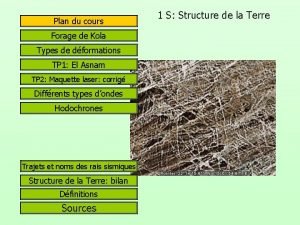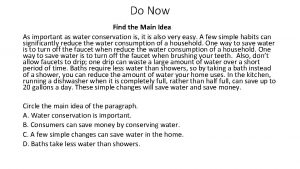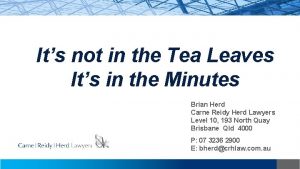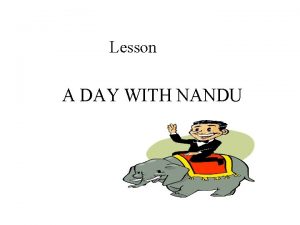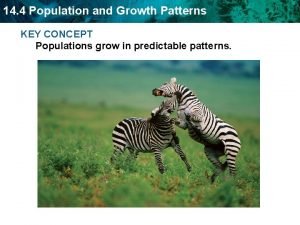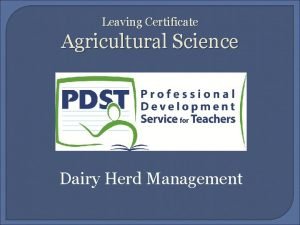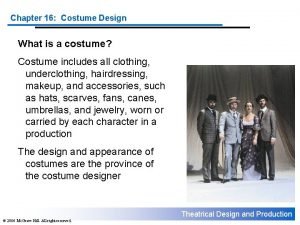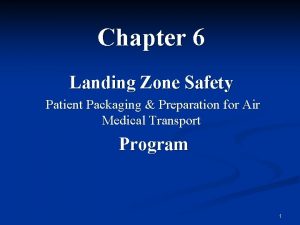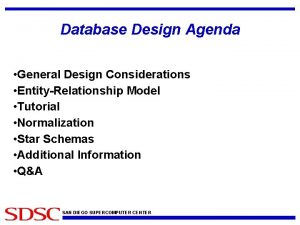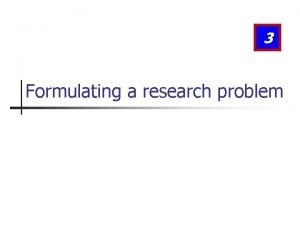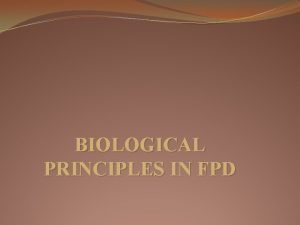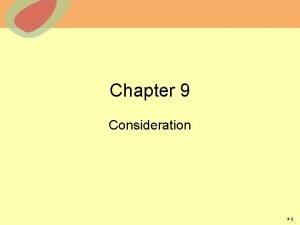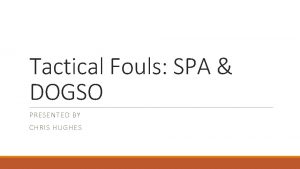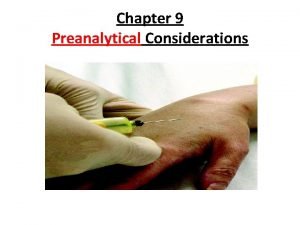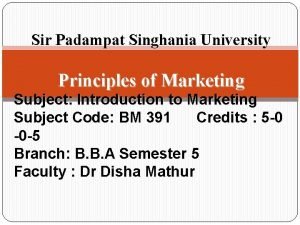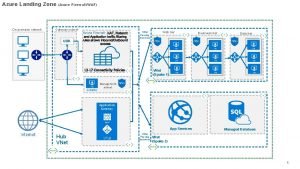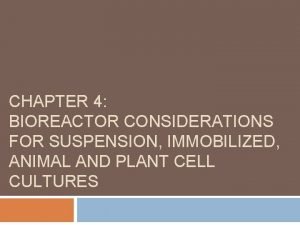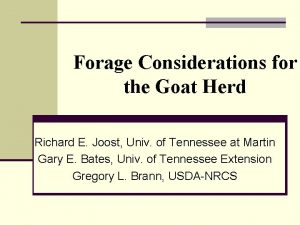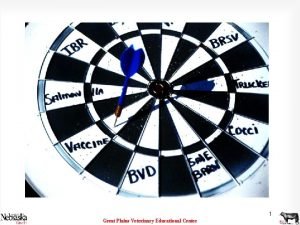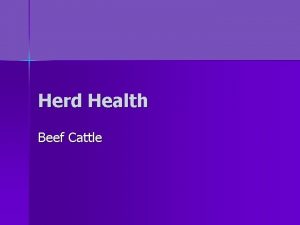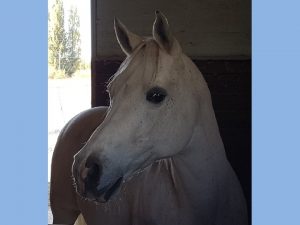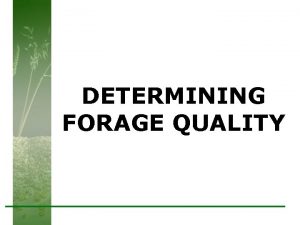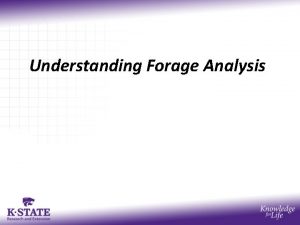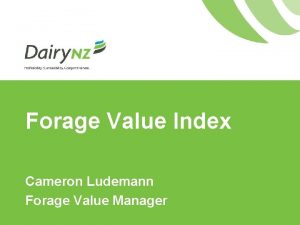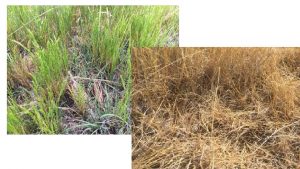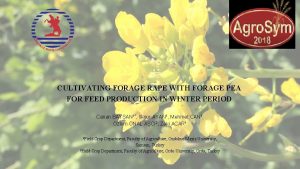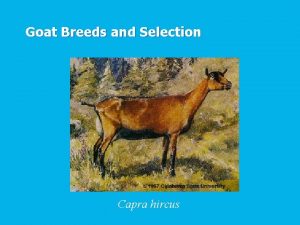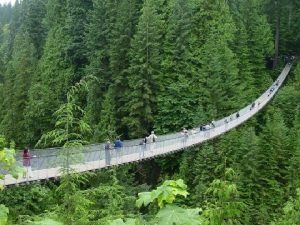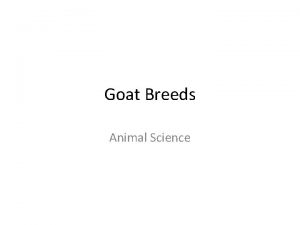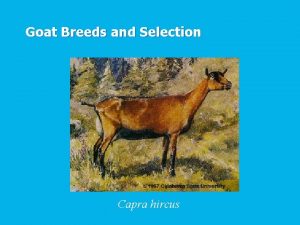Forage Considerations for the Goat Herd Richard E















































































- Slides: 79

Forage Considerations for the Goat Herd Richard E. Joost, Univ. of Tennessee at Martin Gary E. Bates, Univ. of Tennessee Extension Gregory L. Brann, USDA-NRCS

Definitions n Grass – any one of a number of plant species that have leaves that are typically longer than they are wide, with parallel veins n Forb –broadleaf plants that are not grasses, sometimes divided to separate out legumes n Legume – plants that produce pod type fruits and are characterized by fixing atmospheric N n Browse – the leaves and growing tips of forbs and woody shrubs

Goats are Browsers!

Botanical Composition of Grazing Animal Diets

Methods of Pasture Establishment 1. Conventional tillage 2. No-till with equipment 3. Broadcast seeding 1. Frost seeding 2. Animal Tread-in

Keys to Successful Pasture Establishment 1. Select the proper seeding rate 2. Plant within the proper seeding date window 3. Insure good soil-seed contact 4. Control competition from weeds and existing species 5. Make sure soil p. H and fertility are adequate 6. Inoculate legumes

Soil Sampling Pasture Systems n A sample should represent a maximum of 20 acres, preferably much less n Avoid sampling within 150 feet of watering points, mineral access, and shade n Use a coring device to take 15 -20 cores from the area the sample will represent n Take to the depth used by the lab you are using n Sample pastures every 3 -5 years

Tolerance of Forage Species to Soil p. H Legumes Cool-season High (5. 8 -6. 5) Warm-Season Alfalfa, Sweet clover, Sainfoin Medium (5. 5 -5. 8) Arrowleaf clover, Ball clover White clover, Red clover, Crimson clover, Subterranean clover, Birdsfoot trefoil Kudzu Sericea lespedeza, Annual lespedezas Johnsongrass, Sorghum-sudangrass Low (5. 1 -5. 5) Bromegrass, Reed canarygrass, Orchardgrass, Wheat, Oats Very Low (Below 5. 1) Tall fescue Ryegrass, Rye, Timothy Pearl millet, Napier, Guinea Dallisgrass Bermudagrass Bahiagrass Crabgrass

Checklist for Forage Stand Failures n Failure to germinate n Dry seedbed n Non-viable seed n Hard or dormant seed n Unfavorable temperature n Herbicide residue n Waterlogged soil n Emergence failure, germination but no emergence n Early seedling stand failure

Checklist for Forage Stand Failures n Failure to germinate n Emergence failure, germination but no emergence n Planted too deep n Soil crusted at surface n Poor seedling vigor n Insects or disease n Extreme temperatures n Too hot or too cold n Early seedling stand failure

Checklist for Forage Stand Failures n Failure to germinate n Emergence failure, germination but no emergence n Early seedling stand failure n Soil too acid or low fertility n Insects or disease n Drought n Weed competition n No legume nodulation n Winterkill n Frost heaving n Sandblasting from high winds n Grazing too early

Managing Soil Fertility n Liming n Impacts nutrient availability and root growth of forage species n Nitrogen n Influences vegetative growth of pasture species, especially grasses n Phosphorus n Important to root growth, especially of seedlings n Potassium n Impacts cold hardiness and disease resistance of forages

Mineral Nutrient Cycling in Pastures

Nutrient Availability in Relation to Soil p. H from Troeh and Thompsen, 2005

Average Annual Nitrogen Fixation by Common Forage Legumes Legume Alfalfa Alsike clover Annual lespedeza Birdsfoot trefoil Ball clover Crimson clover Hairy vetch Red clover Sweet clover White clover Annual N Fixation (kg/ha) 150 -350 20 -165 50 -193 30 -130 34 -112 56 -230 110 -168 60 -200 70 -140 112 -190

Palatability n Physical factors n Texture n Hairiness n Thorns and spines n Succulence n Leafiness n Chemical factors n Aroma n Sugar content n Fertilization/mineral content

Grazing Preference - dependent on forages available and animals experience n Desirable n Multiflora rose n Briars n Ironweed n Ragweed n Lambsquarter n Sericea lespedeza n Annual lespedezas n Honeysuckle n Spiny amaranth n pigweed n Privet n Kudzu n Buckbush n Curly dock n Winter annuals n Intermediate n bermuda n Chickweed n Thistle n Burdock n Tree of heaven n White clover n Buttercup n Japanese grass n Undesirable n Horse nettle n Black nightshade n Perilla mint n Poison hemlock

Proximate Analysis 1. Moisture Oven dry at 135°C 2. Ash Inorganic constituents remaining after ashing at >600°C in muffle furnace 3. Crude Protein (CP) N content X 6. 25 Kjeldahl distillation Assumes all N is in protein and all protein is 16% N

Proximate Analysis - Continued 4. Ether Extract Fats, oils, waxes, resins, and pigments 5. Crude Fiber Digest in dilute acid, dilute alkali Residue – Ash = Crude Fiber Consists of cellulose, lignin and hemicellulose 6. Nitrogen Free Extract (NFE) 100 – (Moisture + Crude Fiber + Ether Extract + Ash + CP) Measures mostly the remaining carbohydrates

TDN Total Digestible Nutrients TDN = DCF + DNFE + DCP + (DEE X 2. 25) Requires digestiblity coefficients for each constituent.

Neutral Detergent Fiber P. J. Van Soest Buffered 2% sodium lauryl sulfate Extracts soluble cell contents and pectins. Residue LIGNIN + CELLULOSE + HEMICELLULOSE Highly correlated with intake. %bw DMI = 120/%NDF

Acid Detergent Fiber 1 N H 2 SO 4 + 2% hexadecyltrimethyl ammonium bromide Extracts hemicellulose and some cellulose. Residue LIGNIN + CELLULOSE Highly correlated with digestibility. DDM%= 88. 9 -(%ADF x 0. 779)

Detergent Fiber Sequence

Forage Quality & Goat Requirements TDN Weanling Does in Early Lactation Dry & Early Pregnant Does Yearling

Forage Quality & Goat Requirements PROTEIN Weanling Does in Early Lactation Yearling Dry and Early Pregnant Does

Protein (%)

Chemical composition of various plants browsed by goats (%) Browse type Crude protein Neutral detergent fiber Calcium Phosphorous Multiflora rose 18. 2 34. 5 0. 99 0. 32 Black locust 23. 0 44. 0 1. 26 0. 21 Honeysuckle 16. 0 34. 5 1. 21 0. 30 Brambles 17. 1 24. 5 0. 23 0. 84 Privet 20. 0 26. 8 0. 89 0. 34 Green briar 16. 1 39. 5 0. 60 0. 18 Trumpet creeper 16. 7 43. 1 0. 42 0. 22

Standard Growth Curve of Forages

The Grass Crown

Plant Growth Habits

Types of Forage Plants 1. Annuals Plants that complete their life cycle in one year and need to be re-seeded to come back 2. Perennials Plants that come back every year from vegetative plant parts without needing to be re-seeded 3. Warm-Season Plants that complete the majority of their growth in the summer at temperatures of 85 -95ºF n Cool-Season Plants that complete the majority of their growth in the fall and spring at temperatures of 65 -75ºF

Cool Season –vs- Warm Season

Perennial Browse Species Warm-Season Cool-Season Cedar Elm Greenbriar Maple Oak Sumac Wild Plum Yaupon Buckbrush Multiflora rose Privet Honeysuckle

Privet Perennial warm-season browse

Multiflora Rose Perennial warm-season browse

Yaupon Perennial warm-season browse

Greenbriar Perennial warm-season browse

Honeysuckle Perennial cool-season browse

Perennial Forb Species Warm-Season Cool-Season Burdock Plantain Goldenrod Ironweed Curly Dock Thistle Chicory Dandelion

Goldenrod Perennial warm-season forb

Ironweed Perennial warm-season forb

Chicory Perennial cool-season forb Seeding rate 4 lbs/acre

Perennial Grass Species Warm-Season Cool-Season Bermudagrass Big bluestem Dallisgrass Eastern gamagrass Indiangrass Johnsongrass Switchgrass Kentucky bluegrass Matua Bromegrass Orchardgrass Reed canarygrass Tall fescue’ Timothy

Bermudagrass Perennial warm-season grass Seeding rate 5 lbs/acre

Big Bluestem Perennial warm-season grass Seeding rate 8 lbs/acre

Johnsongrass Perennial warm-season grass Seeding rate 20 lbs/acre

Tall Fescue Perennial cool-season grass Seeding rate 20 lbs/acre

Timothy Perennial cool-season grass Seeding rate 8 lbs/acre

Perennial Legume Species Warm-Season Cool-Season Illinois bundleflower Kudzu Sericea lespedeza Alfalfa Birdsfoot trefoil Red clover Sweetclover White clover

Illinois Bundleflower Perennial warm-season legume Seeding Rate 13 lbs/acre

Sericea lespedeza Perennial warm-season legume Seeding Rate 25 lbs/acre

Kudzu Perennial warm-season legume

Alfalfa Perennial cool-season legume Seeding rate 15 lbs/acre

Annual Forb Species Warm-Season Cool-Season Lambsquarter Pigweed Spiny amaranth Ragweed Forage rape Kale Swedes Turnips

Lambsquarter Annual warm-season forb

Pigweed Annual warm-season forb

Pigweed Annual warm-season forb

Ragweed Annual warm-season forb

Forage Rapeseed Annual cool-season forb

Annual Grass Species Warm-Season Cool-Season Broadleaf signalgrass Crabgrass Foxtails Pearl millet Sorghum-sudangrass Oats Ryegrass Triticale

Broadleaf Signalgrass Annual warm-season grass

Foxtail Annual warm-season grass

Annual Legume Species Warm-Season Cool-Season Cowpea Hemp sesbania Korean lespedeza Partridge pea Striate lespedeza Arrowleaf clover Berseem clover Crimson clover Vetch

Striate lespedeza Annual warm-season legume Seeding rate 25 lbs/acre

Hemp sesbania Annual warm-season legume

Partridge pea Annual warm-season legume

Crimson clover Annual cool-season legume Seeding rate 20 lbs/acre

Grazing Management Definition Manipulation of animal grazing to supply the forage needed for the grazing animal to achieve production goals while obtaining desired plant, land economic responses.

GRAZING HEIGHT, FROM SOIL SURFACE HIGHER …. TO LOWER Goat >Cattle > Sheep > Horse

Rotational vs. Continuous Stocking

Guidelines for Grazing System Design 1. 2. 3. 4. 5. 6. Water placement Paddock shape Number of paddocks Follow the landscape Use of similar grazing capacities Plan alleyways for animal movement only

Impact of Distance to Water on Forage Utilization

Paddock Shape § Keep paddocks as near square as possible § Improves uniformity of grazing § Interacts with distance to water § With shorter grazing periods, shape is less critical § Amount of fencing required varies with paddock shape Area = 1 acre Perimeter = 834. 84 ft. Area = 1 acre Perimeter = 1043. 55 ft. Area = 1 acre Perimeter = 1147. 9 ft.

Number of Paddocks n Select based on utilization and performance goals n Consider grazing tolerance of forages n Base on regrowth characteristics of forages n Look at the economic potential of various systems Paddocks needed = (Rest period/Grazing period) + 1

Follow the Landscape n Allows producers to better fit forages to soil capability n Provides better ability to pull paddocks out of rotation for hay harvest n Evens out pasture productivity

Use Similar Grazing Capacities § Better maintains forage availability and quality throughout a grazing period § Keeping paddocks similar sized may result in nutritional stress § Need to focus on stocking rate and animal production when setting fences

Impact of Grazing Rotation on Forage Quality

Parasitized Goat

Parasite Larvae in a Dew Drop
 Forage de kola
Forage de kola Highlight or underline key ideas in each passage
Highlight or underline key ideas in each passage Carne reidy herd
Carne reidy herd An elephant herd has mainly female and baby elephant
An elephant herd has mainly female and baby elephant What is the movement of a single caribou into a herd
What is the movement of a single caribou into a herd Herd
Herd Herd learning
Herd learning King richard iii and looking for richard
King richard iii and looking for richard General consideration of machine design
General consideration of machine design Moral consideration in ethics
Moral consideration in ethics T piece ventilation
T piece ventilation Capk expired
Capk expired Biopharmaceutic considerations in drug product design
Biopharmaceutic considerations in drug product design Mechanical considerations of transmission line
Mechanical considerations of transmission line Cloud delivery models
Cloud delivery models Eswl anesthesia considerations
Eswl anesthesia considerations Practical considerations for costume design might include
Practical considerations for costume design might include Convection pdhpe
Convection pdhpe Collaboration design considerations
Collaboration design considerations Tax considerations for setting up a new business
Tax considerations for setting up a new business Azure landing zone considerations
Azure landing zone considerations Ethical considerations examples
Ethical considerations examples Retro mylohyoid curtain
Retro mylohyoid curtain Writing strategies and ethical considerations
Writing strategies and ethical considerations Database design considerations
Database design considerations Dissect the broad area into sub-areas
Dissect the broad area into sub-areas Pricing considerations and approaches
Pricing considerations and approaches Design considerations for mobile computing
Design considerations for mobile computing Spurt and shunt muscles
Spurt and shunt muscles Tooth preparation in fpd
Tooth preparation in fpd Atm kiosk software
Atm kiosk software Data warehouse considerations
Data warehouse considerations Consideration examples
Consideration examples Dogso vs spa
Dogso vs spa Pre analytical considerations in phlebotomy
Pre analytical considerations in phlebotomy Compare and contrast first and second language acquisition
Compare and contrast first and second language acquisition Operational considerations definition
Operational considerations definition Research paper appendices example
Research paper appendices example Experimental design and ethical considerations
Experimental design and ethical considerations Anatomical considerations
Anatomical considerations Three considerations of societal marketing concept
Three considerations of societal marketing concept Microsoft azure landing zone
Microsoft azure landing zone Web security considerations
Web security considerations Final design icon
Final design icon Bioreactor considerations for animal cell culture
Bioreactor considerations for animal cell culture Strategi för svensk viltförvaltning
Strategi för svensk viltförvaltning Varför kallas perioden 1918-1939 för mellankrigstiden
Varför kallas perioden 1918-1939 för mellankrigstiden Verksamhetsanalys exempel
Verksamhetsanalys exempel Matematisk modellering eksempel
Matematisk modellering eksempel Cks
Cks Läkarutlåtande för livränta
Läkarutlåtande för livränta Kyssande vind
Kyssande vind Anatomi organ reproduksi
Anatomi organ reproduksi Tack för att ni lyssnade
Tack för att ni lyssnade Egg för emanuel
Egg för emanuel Typiska novell drag
Typiska novell drag Standardavvikelse
Standardavvikelse Rutin för avvikelsehantering
Rutin för avvikelsehantering Tack för att ni har lyssnat
Tack för att ni har lyssnat Klassificeringsstruktur för kommunala verksamheter
Klassificeringsstruktur för kommunala verksamheter Vanlig celldelning
Vanlig celldelning Påbyggnader för flakfordon
Påbyggnader för flakfordon Rbk-mätning
Rbk-mätning Mall för debattartikel
Mall för debattartikel Myndigheten för delaktighet
Myndigheten för delaktighet Tobinskatten för och nackdelar
Tobinskatten för och nackdelar Kung som dog 1611
Kung som dog 1611 En lathund för arbete med kontinuitetshantering
En lathund för arbete med kontinuitetshantering Atmosfr
Atmosfr Lågenergihus nyproduktion
Lågenergihus nyproduktion Stig karttecken
Stig karttecken Presentera för publik crossboss
Presentera för publik crossboss Större än
Större än Vad är densitet
Vad är densitet Elektronik för barn
Elektronik för barn Tack för att ni lyssnade bild
Tack för att ni lyssnade bild Tack för att ni har lyssnat
Tack för att ni har lyssnat Hur ser ett referat ut
Hur ser ett referat ut Bris för vuxna
Bris för vuxna Epiteltyper
Epiteltyper
